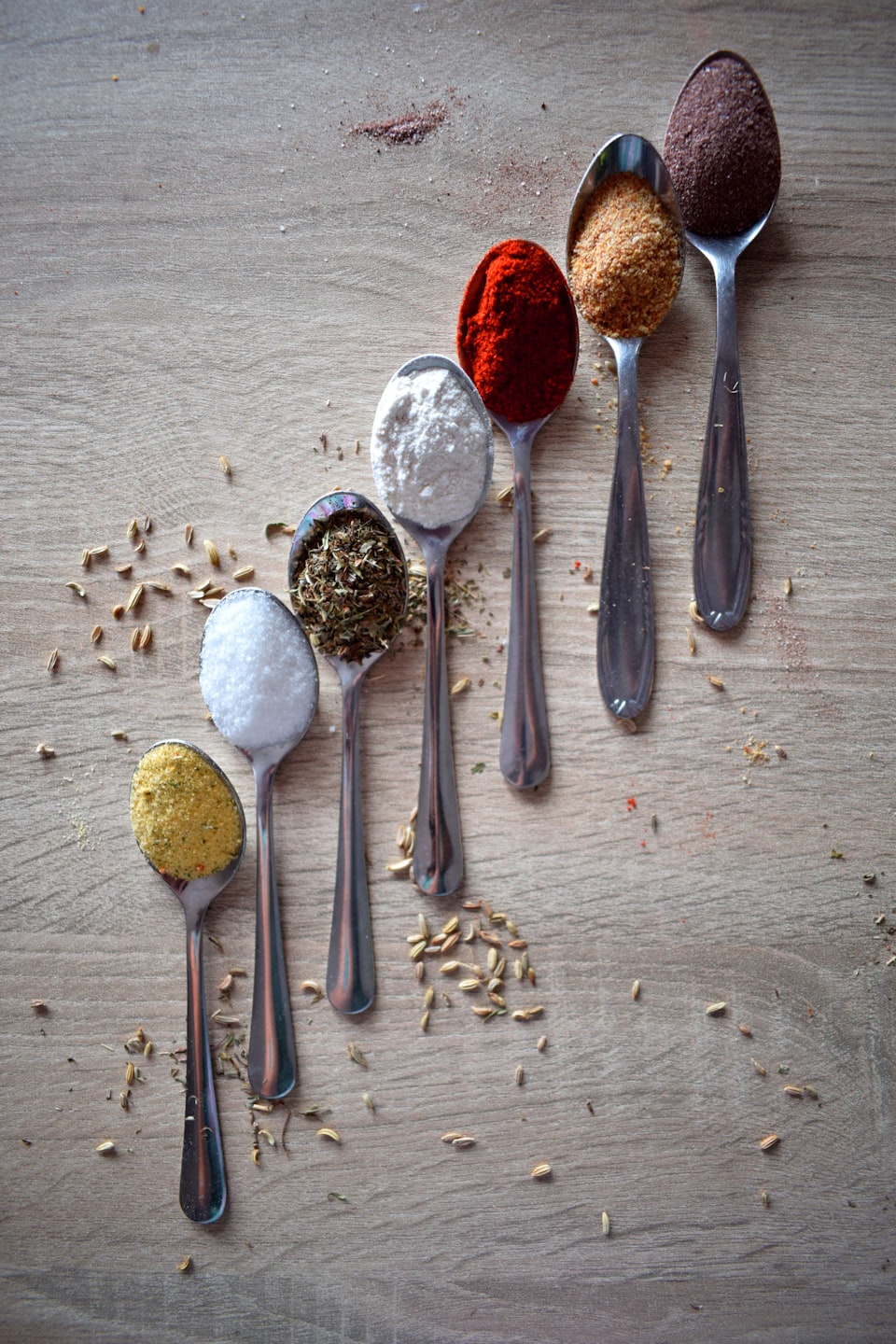The Six Tastes According to Ayurveda

The five elements (ether, air, fire, water, earth) come together to form three doshas - vata, pitta, and kapha. The five elements also come together to form six tastes - sweet (mandhura), sour (amla), salty (lavana), pungent (katu), bitter (tikta), and astringent (kashaya). The breakdown of the predominant elements creating the predominant taste can be seen below:
- Earth + Water = Sweet
- Earth + Fire = Sour
- Water + Fire = Salty
- Air + Fire = Pungent
- Air + Ether = Bitter
- Air + Earth = Astringent
The taste, or rasa, is first felt on the tongue. Through the digestive process, different tastes are predominant. More on the digestive process can be found here. In this post, I will be focusing on the specific actions of each taste.
Sweet/Madhura
The sweet taste might be the easiest to understand. It is pleasant and agreeable. For most people, the first interaction with the sweet taste is from the mother's milk. The sweet taste is comforting and grounding. Dr. Vasant Lad says "Love is madhura, so you call a person you love 'honey.' You never say 'Oh, my chili pepper'."
The sweet taste has many benefits including producing strength in body tissues, improving skin complexion, strength for the sense organs and ojas, and increasing breastmilk for nursing mothers. It increases love and compassion. In excess, it can lead to an increase in body fat and weight, kapha disorders, cancer, diabetes, asthma, reduced healing capacity and more. It can cause greed and attachment.
Examples of sweet foods: honey, milk, wheat, rice, some meats.
Elements: Earth + Water
Qualities: Heavy, cooling, and oil
Pacifies: Vata and Pitta
Aggravates: Kapha
Felt on the Tongue: Tip of the tongue
Organ: Thyroid and upper lungs
Sour/Amla
The sour taste causes an instant reaction. When you think of eating something sour, your mouth immediately puckers, and saliva production is increased. The sour taste stimulates the metabolism.
The sour tastes has benefits ranging from stimulating agni to making the inactive vata move downward. The sour taste increases alertness, brings about comprehension, and attention. In excess, the sour taste brings a loss of strength, itching, and skin problems. It can cause the mind to become agitated and hyperactive. To quote Dr. Vasant Lad "When a relationship ends, there is often a sour taste in the mouth, which is a sign of judgement and rejection."
Examples of sour foods: yogurt, vinegar, citrus fruits, fermented foods
Elements: Earth + Fire
Qualities: Light, liquid, heating, and oily
Pacifies: Vata
Aggravates: Pitta and Kapha
Felt on the Tongue: Front sides of the tongue
Organ: Lungs
Salty/Lavana
Salt is another easier taste to understand. Just think salt! Salt enhances the flavor of food, contains many important minerals, and helps to maintain an electrolyte balance. The benefits of salt also include the ability to clear obstructions of the channels, the ability to penetrate deep into the tissues, and aiding in digestion and elimination. The taste of salt increases spirits, confidence and courage. In excess, salt causes thirst, skin diseases, wrinkles, sodium retention, thickening of the blood. It can also create temptation, addiction, attachment, and other kapha disorders. How many people can open a bag of chips and limit themselves to a single handful?
Examples of salty foods: rock salt, pink salt, all salts, seaweed, tamari
Elements: Water + Fire
Qualities: Heating, heavy, oily
Pacifies: Vata
Aggravates: Pitta and Kapha
Felt on the Tongue: Back sides of the tongue
Organ: Kidneys
Pungent/ Katu
The pungent taste is a circulatory stimulant. It is commonly found in many spices like cumin, cinnamon and turmeric. It aids in digestion, cleansing and improves taste. Additional benefits include antiviral and antibacterial properties, kindling agni, and cleans the mouth. It removes obstructions and brings clarity of perception. It helps the mind to become sharp. In excess, it can cause diseases of the throat, skin problems, inflammation, and can be carcinogenic. It can also make the mind angry, violent and irritable. If a person feels angry, they should stay away from pungent foods.
Examples of pungent foods: black pepper, mustard, ginger, onion, garlic
Elements: Air + Fire
Qualities: Light, dry and heating
Pacifies: Kapha
Aggravates: Vata and Pitta
Felt on the Tongue: center of the tongue towards the front
Organ: Stomach and heart
Bitter/Tikta
The bitter taste does not taste good on its own but it does improve all other tastes. It is anti-toxic and kills germs. It helps with the reduction of a fever, can relieve intestinal gas, and works as a drying agent in the body. Additional benefits include curing thirst, skin diseases, and burning sensations as well as increasing intelligence. In excess, the bitter taste can create nausea, depletes the bones, and leads to vata diseases. The taste is associated with aversion, detachment ultimately leading to loneliness and depression.
Examples of bitter foods: Aloe vera, neem, coffee, dandelion greens
Elements: Air + Ether
Qualities: Cool, light, and dry
Pacifies: Pitta and Kapha
Aggravates: Vata
Felt on the Tongue: The middle of the tongue
Organ: Pancreas, liver, spleen
Astringent/ Kasaya
The astringent taste can create a dry, choking sensation in the throat. Most uncooked, raw vegetables have an astringent taste. Due to the earth element present in the astringent taste it helps to bind the stool; so, this taste can be helpful if a person has diarrhea.
Benefits of the astringent taste include improving absorption in the colon, works as a decongestant, has anti-inflammatory properties. It brings things together in the body and mind. The mind can feel organized and settled. In excess, the taste can cause spasms, constipation, blood clotting, insomnia, fear, and nervousness.
Examples of astringent foods: chickpeas, pomegranate, yellow split peas
Elements: Air + Earth
Qualities: Cooling, dry, heavy
Pacifies: Pitta and Kapha
Aggravates: Vata
Felt on the Tongue: The middle back of the tongue
Organ: Colon
Overview
The six tastes are ideally present within each meal but can also be present through the cumulation of meals throughout the day. The tastes are comprised of two elements each of which lend their individual qualities. The proportion of taste per meal is determined by your constitution. For example (and in general), a vata-predominant person should have a larger portion of sweet foods on their plate; whereas a person with a kapha predominance would have a smaller portion of the sweet taste.
Vata is pacified by the following tastes: sweet, sour, and salty
Pitta is pacified by the following tastes: sweet, bitter, and astringent
Kapha is pacified by the following tastes: pungent, bitter, and astringent
Understanding the taste and qualities of the food you are consuming will assist not only with digestion but will also create more energy and vitality! If you are feeling bogged down, have irregular and stinky bowel movements, bloating, gas, depressed then those are good indicators you are eating in a way that does not align with your dosha. Food should leave you feeling alert, content, energized, and satisfied! Let food be the medicine that feeds your soul!
Happy eating :)





